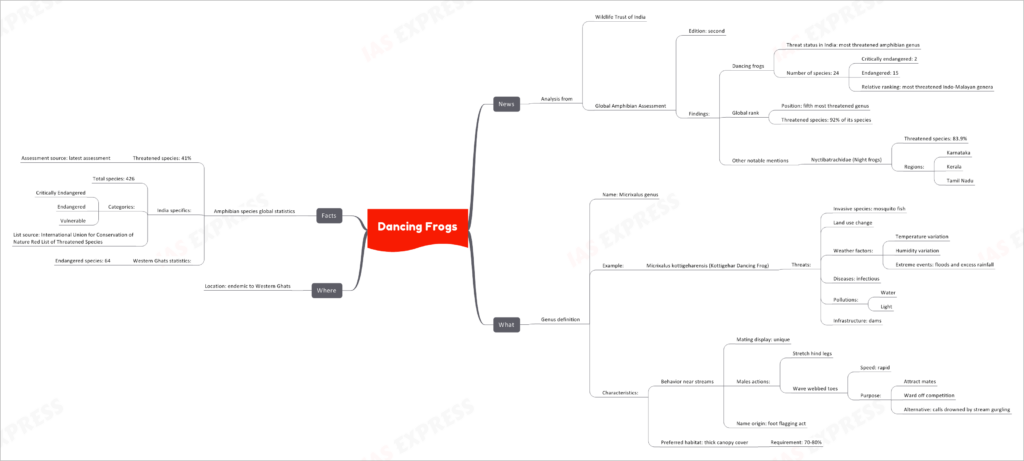Dancing Frogs

In recent news, alarming findings from the Wildlife Trust of India and the Global Amphibian Assessment’s second edition have shed light on the plight of dancing frogs, specifically the Micrixalus genus, in the Western Ghats of India.
This topic of “Dancing Frogs” is important from the perspective of the UPSC IAS Examination, which falls under General Studies Portion.
Threat Status of Dancing Frogs in India
Most Threatened Amphibian Genus
The Micrixalus genus, commonly known as dancing frogs, faces a grave threat in India. According to the assessment, it is considered the most threatened amphibian genus in the country.
Number of Species
Within the Micrixalus genus, there are a total of 24 species, each facing its own set of challenges. These species can be categorized as follows:
- Critically Endangered: 2 species
- Endangered: 15 species
- Relative Ranking: Among the most threatened Indo-Malayan genera
Global Ranking
Fifth Most Threatened Genus Worldwide
Dancing frogs are not just a concern in India; they have garnered the status of being the fifth most threatened genus on a global scale.
High Percentage of Threatened Species
A staggering 92% of its species are considered threatened, highlighting the severity of the issue.
Other Notable Mentions
Aside from the Micrixalus genus, another group of frogs, the Nyctibatrachidae, also known as night frogs, face a significant threat. Here are some key points:
Threatened Species
Approximately 83.9% of night frog species are under threat.
Affected Regions
Night frogs are primarily found in the states of Karnataka, Kerala, and Tamil Nadu, making these regions crucial for conservation efforts.
What Defines the Micrixalus Genus
Genus Definition
The Micrixalus genus, characterized by dancing frogs, includes species like the Micrixalus kottigeharensis, commonly known as the Kottigehar Dancing Frog.
Threats
These dancing frogs encounter a multitude of threats, including:
- Invasive Species: Mosquito fish
- Land Use Change
- Weather Factors: Temperature and humidity variations, as well as extreme events like floods and excess rainfall
- Diseases: Infectious diseases
- Pollutions: Water and light pollution
- Infrastructure: Dam construction
Unique Characteristics
Dancing frogs exhibit unique behavior and characteristics, such as:
Behavior Near Streams
- Mating Display: A distinctive mating display
- Male Actions: Males stretch hind legs and wave webbed toes rapidly to:
- Attract mates
- Ward off competition
- Alternately, calls are drowned out by the stream’s gurgling
- Name Origin: “Foot flagging” act during mating displays
Preferred Habitat
These frogs thrive in habitats with a thick canopy cover, with a requirement of 70-80% for their survival.
Where to Find Dancing Frogs
Location
Dancing frogs, specifically the Micrixalus genus, are endemic to the Western Ghats in India, making this region a critical focus for conservation efforts.
Facts and Figures
Amphibian Species Global Statistics
- Threatened Species: Globally, 41% of amphibian species are threatened, as per the latest assessment.
India Specifics
- In India, there are a total of 426 amphibian species falling into categories such as Critically Endangered, Endangered, and Vulnerable, according to the International Union for Conservation of Nature Red List of Threatened Species.
Western Ghats Statistics
- Within the Western Ghats, 64 amphibian species are classified as endangered, emphasizing the importance of conservation initiatives in this region.

